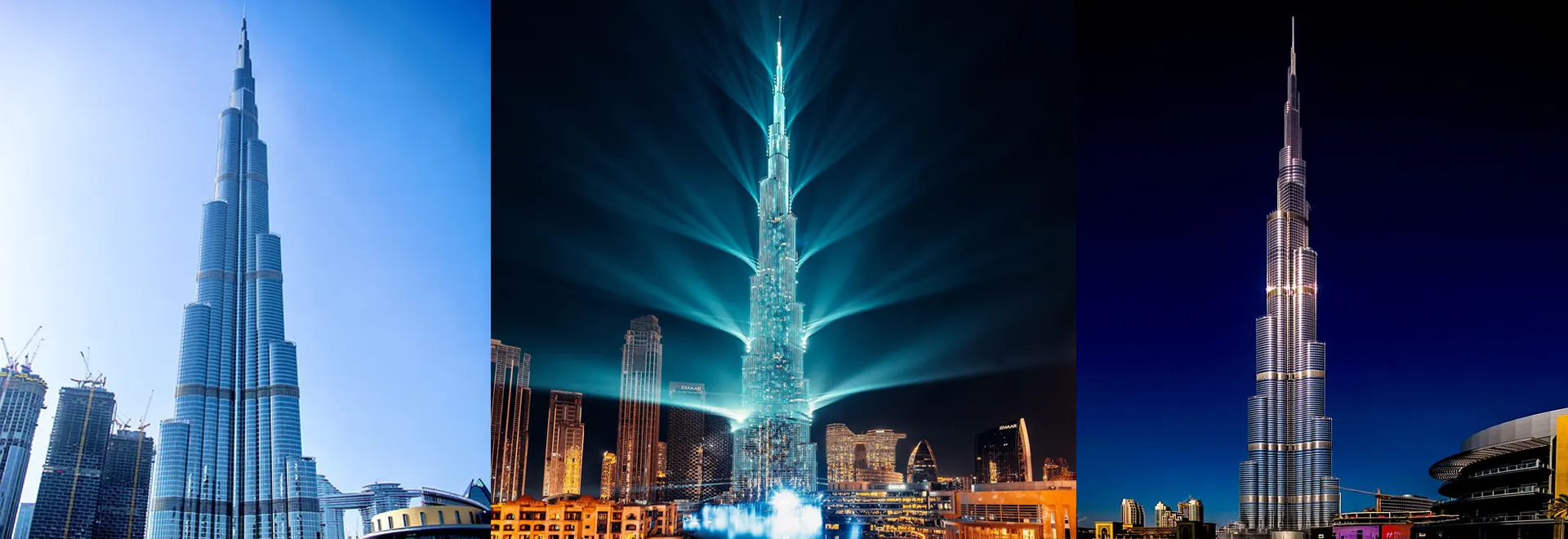Burj Khalifa: A Symbol of Ambition and Innovation
The Burj Khalifa, standing at an awe-inspiring 828 meters (2,717 feet), is not just the tallest building in the world but a testament to human ambition, creativity, and engineering prowess. This architectural marvel has become a global icon and a symbol of Dubai’s rapid transformation into a global city. But how did this towering structure come to life? Let’s delve into its origins, the challenges faced during its construction, and the triumph that followed.
The Idea Behind Burj Khalifa

The idea of the Burj Khalifa was born in the early 2000s, during a period when Dubai was expanding rapidly. The vision behind the building was to create something unprecedented—an architectural masterpiece that would symbolize the city’s futuristic aspirations. Emaar Properties, a Dubai-based real estate company, spearheaded the project with the goal of not only setting a new world record but also positioning Dubai as a hub for luxury tourism, business, and innovation.
Inspired by structures like the Empire State Building and the Sears Tower, the leadership in Dubai aimed for more than just another skyscraper. They wanted something that would define the skyline and stand as a global benchmark for architectural achievement. With this audacious vision, they set out to create what would become the tallest man-made structure on Earth.
Concept and Design
The design of the Burj Khalifa was created by Adrian Smith, an architect with Skidmore, Owings & Merrill (SOM), a renowned American architectural firm. The design was inspired by Islamic architecture, particularly the geometrical patterns found in traditional mosques, and it incorporated elements from the Hymenocallis flower, with its long petals radiating from a central core.
The tower’s Y-shaped structure not only provides aesthetic appeal but also serves a functional purpose, offering greater structural stability and making efficient use of space. This unique design allowed the building to rise to extraordinary heights while remaining resistant to the harsh desert winds.
The Challenge of Construction

Constructing the Burj Khalifa was a monumental task that took five years to complete, from 2004 to 2009. The sheer scale of the project posed numerous engineering and logistical challenges. For starters, the building’s foundations had to support a colossal weight, requiring the use of over 45,000 cubic meters of concrete, reinforced with steel rebar. Deep foundations were built using bored piles sunk 50 meters into the ground to ensure stability.
Another challenge was dealing with Dubai’s hot and windy climate. Temperatures can soar above 50°C in the summer, which can weaken materials like concrete and steel if not properly managed. To combat this, a special concrete mix was used that could withstand both the heat and the forces exerted by the wind at such great heights.
The high-altitude construction added an extra layer of complexity. As the building rose higher, cranes and other machinery had to operate at dizzying altitudes. At the peak, construction workers had to be transported using specially designed elevators, which also required temperature control to ensure the safety of the crew.
Engineering Feats and Innovative Solutions

One of the most significant engineering challenges was counteracting the wind forces that could cause the building to sway. The architects designed the tower in such a way that its spiraling shape disrupts wind patterns, preventing dangerous oscillations. Additionally, a damper system was installed inside the tower to further reduce the effects of wind.
Another innovative solution was the construction sequence itself. Burj Khalifa was built using a method known as “jump form construction,” allowing each floor to be constructed one at a time in a repetitive, highly efficient process. This enabled the team to complete one floor every three days at the peak of construction activity.
Interior and Beyond: A Luxurious Experience
Burj Khalifa isn’t just a feat of engineering—it’s also a masterpiece of interior design and luxury. The tower houses residential apartments, corporate suites, a world-class hotel designed by Giorgio Armani, and numerous observation decks that offer panoramic views of the city and beyond. The interiors feature a blend of contemporary design elements with Middle Eastern motifs, creating a harmonious blend of modernity and tradition.
One of the tower’s most famous features is the observation deck on the 148th floor, called “At the Top.” It offers an unparalleled view of Dubai, the Arabian Gulf, and the vast desert that surrounds the city.
Opening and Global Recognition

On January 4, 2010, Burj Khalifa was officially inaugurated in a spectacular ceremony attended by dignitaries and leaders from around the world. The building was originally named “Burj Dubai,” but was renamed in honor of Sheikh Khalifa bin Zayed Al Nahyan, the ruler of Abu Dhabi, who played a significant role in supporting Dubai during the financial crisis.
Since its opening, Burj Khalifa has won numerous awards and has become one of the most visited tourist attractions globally. Its reputation as a symbol of Dubai’s success and ambition continues to attract millions of visitors each year.
A Monument to Human Achievement
The Burj Khalifa is more than just the tallest building in the world. It’s a symbol of the possibilities that can be achieved through vision, perseverance, and innovation. From its conception to its construction and beyond, the Burj Khalifa represents a monumental achievement in both architectural and human history. As it towers above the Dubai skyline, it stands as a reminder of what can be accomplished when ambition meets ingenuity.
Insights into Burj Khalifa: What Makes It a Global Icon?
The Burj Khalifa’s towering presence is a reflection of Dubai’s audacious spirit, but there are many lesser-known aspects that add to the building’s allure. From its groundbreaking construction techniques to its innovative environmental design, here are some additional insights into the world’s tallest building.
Engineering Marvel: A Structural Symphony

The Burj Khalifa’s structural system is a marvel in itself. The “buttressed core” system, which uses a central hexagonal core supported by three buttresses arranged in a Y-shape, is what allows the building to rise to such extreme heights. This unique design distributes the weight of the building evenly, providing both stability and balance. As the tower ascends, its floors taper inwards, giving the structure its iconic, slender profile.
One fascinating detail is the building’s sway. Like all skyscrapers, Burj Khalifa experiences a degree of movement due to wind forces. However, this sway is minimized to a barely perceptible level thanks to its aerodynamic shape and sophisticated dampening systems. By continuously adjusting the shape as it rises, the architects and engineers effectively “confused” the wind, preventing strong gusts from causing excessive motion.
Innovations in Material and Construction
The materials used in Burj Khalifa are as extraordinary as the building itself. More than 330,000 cubic meters of concrete and 39,000 tonnes of steel rebar were used in its construction. The glass cladding alone covers 103,000 square meters and had to be engineered to withstand Dubai’s extreme weather conditions, including high heat and wind.
A key feature of Burj Khalifa is its cooling system. Given Dubai’s intense heat, cooling such a massive structure presented a challenge. A centralized cooling system was installed, with water sourced from a cooling plant adjacent to the tower. This system chills more than 10,000 tonnes of water daily to keep the building at comfortable temperatures.
Even the concrete used was specially developed to handle Dubai’s climate. Regular concrete would crack under such intense heat, so the construction team poured the concrete at night when temperatures were lower, preventing it from setting too quickly.
Water and Air: Environmental Considerations
The Burj Khalifa has an advanced water collection system that recycles condensation from the building’s air conditioning systems. The tower produces an estimated 15 million gallons of water annually from this condensation, which is collected and used for landscaping and other non-potable purposes. This is a key feature of its sustainability efforts, contributing to the preservation of Dubai’s water resources.
Additionally, a sophisticated air filtration system was installed to ensure clean air inside the building. Given the height and potential exposure to dust from the surrounding desert, the filtration system was designed to maintain optimal air quality.
Record-Breaking Elevators
The Burj Khalifa also holds the record for the tallest service elevator in the world, which travels a staggering 504 meters. The building’s elevators are among the fastest in the world, capable of traveling at 10 meters per second. These double-deck elevators are equipped with multimedia entertainment screens to enhance the experience of visitors as they ascend to the observation decks.
Given the vast height, the elevators are divided into different zones for residential, office, and visitor areas. To make the ride smooth and comfortable, the elevators slow down as they approach their destinations, ensuring passengers are not overwhelmed by the rapid change in altitude.
Lighting: A Beacon in the Night
One of the most mesmerizing features of Burj Khalifa is its lighting. The tower is equipped with over 2,900,000 LED lights that illuminate it at night, creating stunning displays. The lighting system is often synchronized with Dubai’s national holidays, New Year celebrations, and other global events, making the Burj Khalifa a living canvas for artistic and cultural expressions. Whether it’s illuminating in the colors of the UAE flag or displaying a tribute to world events, the building never fails to dazzle.
The crown of the Burj Khalifa also features an intricate lighting system that makes the spire visible from kilometers away. This feature adds to its appeal as a nighttime spectacle, ensuring that Burj Khalifa dominates the skyline even after the sun has set.
A Symbol of Collaboration
While Burj Khalifa is an emblem of Dubai’s achievements, its creation was the result of international collaboration. Engineers, architects, and construction workers from over 100 countries contributed to its completion. The project brought together expertise from around the world, highlighting the global nature of modern construction.
This collaboration extended beyond just construction. Designers, sustainability experts, and luxury brands also played their part in shaping Burj Khalifa’s interior and experience, from Armani’s design of the hotel spaces to the intricate landscaping around the building.
Global Impact and Cultural Significance
Since its inauguration, Burj Khalifa has become a cultural icon, not just for Dubai but for the entire world. It has been featured in numerous movies, including Hollywood blockbusters like Mission: Impossible – Ghost Protocol, where Tom Cruise famously scaled the tower. The building is a backdrop for international events, including the annual New Year’s Eve fireworks show, which attracts millions of viewers globally.
But beyond the glitz and glamour, Burj Khalifa has a more profound meaning. It represents human perseverance and the boundless ambition to push the limits of what is possible. Its construction required overcoming numerous obstacles, from financial challenges to environmental constraints. Yet, it stands today as a reminder of what can be achieved when innovation, creativity, and determination come together.
The Legacy of Burj Khalifa
The Burj Khalifa isn’t just the tallest building on the planet—it’s a testament to human vision and engineering mastery. It symbolizes not only Dubai’s meteoric rise but also the potential for cities and nations to dream big. While it remains a must-visit destination for millions of tourists, it also serves as a daily inspiration to those who aspire to achieve the impossible.
Its legacy is more than its height; it lies in the fact that the Burj Khalifa has redefined what modern architecture can accomplish. Whether you’re admiring it from afar or experiencing its breathtaking views from the top, the Burj Khalifa is a constant reminder that the sky is not the limit—it’s just the beginning.



